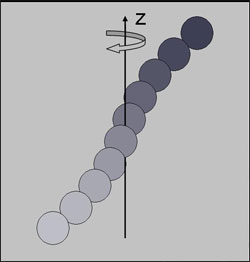Mix Master Magnets
A rotating magnetic field can induce tiny beads in a fluid to link up into spinning strings, researchers report in the July Physical Review E. The team measured the effects of different field configurations to find the most efficient way to use the beads to stir the fluid. These “self-assembled stir bars” could mix even the hard-to-stir fluids in micron-sized channels within miniaturized chemical analysis chips that are in development.
In an upward-pointing magnetic field, magnetizable particles in a fluid join together into vertical “strings,” as each particle becomes a tiny magnet with its north pole above and south pole below. In contrast, a field that rapidly rotates in the horizontal plane tends to break up vertical chains, because magnets with sideways-aligned poles won’t stack vertically.
Several years ago, James Martin and his colleagues at Sandia National Laboratories in Albuquerque, New Mexico, thought they might use these competing effects to fine tune particle arrangements that they would eventually solidify into useful materials. But when they built an apparatus to control and change the magnetic field strength over time in three perpendicular directions, the particles did things that were “unbelievably complicated,” Martin says. “It was overwhelming, the number of things that we discovered.” Along the way, he recalls, “we’d see these little tornados in the solution.”
The researchers have now explained the origin of these tornadoes and described the factors that influence them. They measured the torque (twisting force) that the field exerts on the fluid through the rotating particle strings. The torque is a direct measure of the difference in flow speed between neighboring regions of fluid, so conditions that maximize torque should let researchers efficiently mix small samples.
Martin and his colleagues placed 4- to 7-micron-diameter, iron-containing particles into 2 millileters of ethanol, benzyl alcohol, or ethylene glycol, and suspended the sample from a thin, nylon fiber. They then turned on the magnetic fields and measured the rotation of the vial to find the torque on the liquid.
According to their results, the vertical field alone creates chains but not torque. The rotating horizontal field by itself also causes little mixing, because instead of chains it results in horizontal sheets of particles that exert little torque. When both fields are present, however, “we get extremely strong mixing, even at modest fields,” Martin says, sometimes even exploding out of the glass container. The net direction of this combined “vortex field” circles around the vertical like the precessing axis of a wobbly top, tracing out the surface of a cone and inducing a similar motion of the particle chains.
Surprisingly, rotating the vortex field faster doesn’t increase the torque. Martin explains that long chains get broken apart by the faster rotation. The same instability of the chains also causes the torque to be insensitive to the fluid viscosity and to the size of the particles. But the torque generated by the particles does go up as the field strength is increased, unlike an ordinary magnetic stir bar from a typical chemistry lab.
Martin has previously shown theoretically that small magnetic fields should be enough to mix even the micron-sized fluid channels that are used for analyzing tiny chemical samples [1]. Stirring is a major challenge in these devices because for small fluid volumes, viscosity becomes a significant impediment to motion. Martin says that the self-assembled stir bars are also much better behaved than their millimeter-sized, chemistry-lab cousins, which often thrash about wildly before settling down to a steady rotation.
“I think the microfluidic applications really have a lot of potential,” says Daniel Klingenberg of the University of Wisconsin in Madison, because of the ability to “mix aggressively on any length scale.” But he suspects the key to using the vortex fields in a commercial device will be replacing the lab apparatus with “a cheap, portable way to create these fields,” which he says is “certainly doable.”
–Don Monroe
Don Monroe is a freelance science writer in Murray Hill, New Jersey.
References
- J. E. Martin, “Theory of Strong Intrinsic Mixing of Particle Suspensions in Vortex Magnetic Fields,” Phys. Rev. E 79, 011503 (2009)





